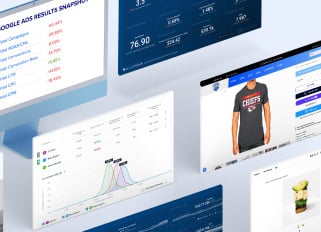
How to Optimize Core Web Vitals for an Ecommerce Site
What does it take for your ecommerce website to rank higher on search engines?
The secret lies in fulfilling the ranking factors that Google calls the Core Web Vitals (CWVs). Understanding how to optimize Core Web Vitals for an ecommerce site can boost your search rankings, improve site performance, and enhance the customer experience.
In 2024, global retail ecommerce sales surpassed $6.3 trillion and are projected to exceed $8 trillion by 2027. This explosive growth presents a massive opportunity for your business—but only if your site delivers a seamless, fast, and engaging experience. Incorporating a strong sales playbook can help you capitalize on this growth effectively.

Image via Statista
Ecommerce is undeniably lucrative but also highly competitive. To stand out, you need a well-optimized website that attracts quality leads and converts them into loyal customers.
In this post, I’ll break down Core Web Vitals and share seven expert-backed strategies to optimize Core Web Vitals for an ecommerce site.
Implement these strategies, and you can enhance user experience, boost SEO performance, and ultimately drive more revenue.
Let’s get right into it.
An Overview of Core Web Vitals
Google places great value on user experience while ranking websites.
A website’s Core Web Vitals are a part of the broader ‘page experience’ signals meant to measure its speed, interactivity, and visual stability. Working on improving these metrics will help boost your SEO visibility score.
The 3 metrics included in the Core Web Vitals are:

Image via web.dev
- Largest Contentful Paint (LCP): Measures how quickly the largest visible content on a webpage loads. A load time of 2.5 seconds or less is ideal.
- Interaction to Next Point (INP): Evaluate your site's responsiveness by tracking how quickly it reacts to user interactions. Faster response times lead to better rankings.
- Cumulative Layout Shift (CLS): Gauges visual stability by assessing unexpected layout shifts. Minimizing intrusive or abrupt changes improves UX and SEO.
Knowing how these Core Web Vitals work will help you quantify your website’s overall performance and user experience.
According to Attrock, it is crucial to optimize Core Web Vitals for an ecommerce site to boost the visibility of your site in search results.
7 Key Tips to Optimize Core Web Vitals for an Ecommerce Site
To deliver an exceptional shopping experience, you must fix technical SEO errors and optimize your website’s Core Web Vitals. Here are seven proven tips to improve your site’s performance and score.
1. Adopt a ‘Mobile First’ Approach
With over 4 billion smartphone users worldwide, mobile shopping dominates ecommerce. According to this Statista survey, smartphones accounted for over 77% of retail website traffic and 68% of total orders in November 2024.

Image via Statista
Adopting a ‘mobile-first’ approach effectively accommodates this massive demographic of smartphone users while improving your Core Web Vitals scores.
Implementing accelerated mobile pages (AMPs) can help your web pages load faster. Start by focusing on the most visited pages and making them mobile-friendly. Creating engaging, easily digestible content and optimizing your layout can also boost user experience and increase sales.
2. Optimize Your Images and Videos
One of the best ways to optimize Core Web Vitals for your ecommerce site is to optimize media elements like images, videos, and animated elements on web pages. You can use professional video software such as Adobe Video Editor to create and edit optimized video content for your ecommerce site.
Some fundamental techniques you can follow are:
- Choose the right image format
- Use an appropriate image compression technique
- Test different image sizes
- Add alt tags for improved image SEO
- Use plugins to optimize images and videos
Using these techniques to optimize images for ecommerce, you can drastically influence your site’s SEO rankings while keeping potential customers engaged.
3. Use a Content Delivery Network
A Content Delivery Network (CDN) can significantly improve website speed and responsiveness by storing copies of your content on servers across multiple global locations.
This ensures that users load your site from the nearest server, reducing latency and enhancing Core Web Vitals performance.
While there are multiple options, you can opt for more reliable ones like Amazon CloudFront. Consider factors like speed offered, ease of integration, and reliability while choosing a CDN.
Adopting these tactics for ecommerce SEO can also help reduce bounce and cart abandonment rates, ultimately increasing conversion and revenue.
4. Choose the Right Hosting Provider
Is your hosting provider making your website load slower? One of the best ways to optimize Core Web Vitals for an ecommerce site is to choose a reliable hosting provider to establish your online business. Some of the most important qualities to look out for are:
- Advanced hosting technology and features
- Good track record
- Ample storage and bandwidth
- Transparent pricing plan
- Efficient customer support
- Robust security and privacy policy
Investing in the right hosting service can help your website rank higher than your competitors and drive more traffic.
5. Minify Your Resource Files
Your HTML, CSS, and JavaScript files greatly impact website speed and Core Web Vitals performance. Minifying these resource files—by removing unnecessary characters, spaces, and redundant code—can drastically improve load times.
Here’s how to optimize your ecommerce site for better performance:
- Combine CSS and JavaScript resource files to minimize HTTP requests
- Eliminate render-blocking resources
- Delay JavaScript loading to load other elements on your page faster
- Use a CSS Sprite Generator to combine multiple icons or small images
- Audit your widgets and plugins regularly
If this sounds too technical, don’t worry, free tools like Minify JS can handle these tasks in just a few clicks and boost your website's performance.
6. Activate Browser Caching
Data caching is another reliable way to optimize Core Web Vitals for an ecommerce website.
Storing copies of static content (like images, stylesheets, and scripts) on a user's browser helps your site avoid having to repeatedly fetch data from the server every time they visit your online store.
Essentially, browser caching saves bandwidth, helping make your web pages faster and more responsive. This can improve customer trust and encourage them to choose you over your competitors.
To optimize caching for your ecommerce site, start by identifying content files that are frequently used and that remain the same for longer.
7. Enable Lazy Loading
Many SEO experts recommend this technique to optimize Core Web Vitals for an ecommerce site.
Lazy loading allows a website to load images as the user interacts with the webpage rather than loading all images upfront. It can make your online store more mobile-friendly, reduce bounce rate, and boost LCP time.
You can use efficient plugins or specific HTML attributes to implement lazy loading. You may get started by testing this on a few landing pages and noting the difference in performance.
Conclusion
Ecommerce success heavily relies on how you attract, engage, and convert visitors into paying customers. Learning how to optimize Core Web Vitals for an ecommerce site can give you a much-needed advantage.
The strategies I have shared here have been proven to help boost website performance, enhance user experience, and improve SEO rankings. Go ahead and adopt them into your ecommerce SEO strategy to beat your competitors and grow your business.
Connect With Us
Recent Post

.png)





Tell us what you think!